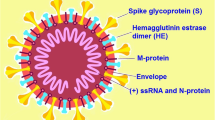Abstract
A novel coronavirus was identified in late 2019 as the cause of a cluster of pneumonia cases in Wuhan, China. It has since rapidly spread resulting in a pandemic. The World Health Organization designated the disease term COVID-19 (Coronavirus Disease 2019). The virus that causes COVID-19 is designated severe acute respiratory syndrome coronavirus 2 (SARS-CoV-2). The major morbidity and mortality from COVID-19 is largely due to acute viral pneumonitis that evolves to acute respiratory distress syndrome (ARDS).
Access this chapter
Tax calculation will be finalised at checkout
Purchases are for personal use only
Similar content being viewed by others
References
Manca D. Analysis of the number growth of ICU patients with Covid-19 in Italy and Lombardy updated to 17-march, day #25 evening; ESA journal march 18th, 2020.
Wunsch H, Linde-Zwirble W, Harrison D, Barnato AE, Rowan KM, Angus DC. Use of intensive care services during terminal hospitalizations in England and the United States. Am J Respir Crit Care Med. 2009;180:875–80.
Institute of Medicine. Crossing the quality chasm: a new health system for the 21st century. Washington, DC: The National Academies Press; 2001.
Gruppo di Studio Ad Hoc della Commissione di Bioetica della SIAARTI. SIAARTI guidelines for admission to and discharge from Intensive Care Units and for the limitation of treatment in intensive care. Minerva Anestesiol. 2003;69:101.
Kim JE, Lee S. Intensive care unit admission protocol controlled by intensivists can reduce transfer delays from the emergency department in critically ill patients. Hong Kong J Emerg Med. 2019;26(2):84–90.
Bion J, Dennis A. Oxford text book critical care (ed. 2): ICU admission and discharge criteria. Oxford: Oxford University Press; 2016.
Nates JL. ICU admission, discharge, and triage guidelines: a framework to enhance clinical operations, development of institutional policies, and further research. Crit Care Med. 2016;44(8):1553–602.
Task Force of the American College of Critical Care Medicine, Society of Critical Care Medcine. Guidelines for intensive care unit admission, discharge, and triage Task Force of the American College of Critical Care Medicine, Society of Critical Care Medicine. Crit Care Med. 1999;27:633–8.
Maves RC, et al. Triage of scarce critical care resources in COVID-19: an implementation guide for regional allocation: an expert panel report of the task force for mass critical care and the American College of Chest Physicians. Chest. 2020;158:212–25.
Cheung WK, Myburgh J, Seppelt IM, et al. A multicentre evaluation of two intensive care unit triage protocols for use in an influenza pandemic. Med J Aust. 2012;197(3):178–81.
United States Department of Health and Human Services. “Topic collection: crisis standards of care.” Accessed 17 Mar 2020.
Charles PG, Wolfe R, Whitby M, et al. SMART-COP: a tool for predicting the need for intensive respiratory or vasopressor support in community-acquired pneumonia. Clin Infect Dis. 2008;47(3):375–84.
España PP, Capelastegui AM, Gorordo I, et al. Development and validation of a clinical prediction rule for severe community-acquired pneumonia. Am J Respir Crit Care Med. 2006;174(11):1249–56.
Duca A, et al. Calculated decisions: Brescia-COVID respiratory severity scale (BCRSS)/algorithm. Emerg Med Pract. 2020;22(5 Suppl):CD1–2.
Giwa A, Desai A, Duca A. Novel 2019 coronavirus SARS-CoV-2 (COVID-19): an updated overview for emergency clinicians. Emerg Med Pract. 2020;22(5):1–28.
Antonelli M, Conti G, Esquinas A, et al. A multiple-center survey on the use in clinical practice of non-invasive ventilation as first-line intervention for acute respiratory distress syndrome. Crit Care Med. 2007;35:18–35.
Landini, Belardinelli et al., Linee di indirizzo per la gestione del percorso COVID-19 in ambito ospedaliero e peri-ospedaliero della regione Toscana. April 2020.
Author information
Authors and Affiliations
Editor information
Editors and Affiliations
Rights and permissions
Copyright information
© 2020 The Editor(s) (if applicable) and The Author(s), under exclusive license to Springer Nature Switzerland AG
About this chapter
Cite this chapter
Vargas, M., Sara, R., Buonanno, P., Servillo, G. (2020). The Screening and the Access to ICU. In: Vargas, N., Esquinas, A.M. (eds) Covid-19 Airway Management and Ventilation Strategy for Critically Ill Older Patients. Springer, Cham. https://doi.org/10.1007/978-3-030-55621-1_7
Download citation
DOI: https://doi.org/10.1007/978-3-030-55621-1_7
Published:
Publisher Name: Springer, Cham
Print ISBN: 978-3-030-55620-4
Online ISBN: 978-3-030-55621-1
eBook Packages: MedicineMedicine (R0)




